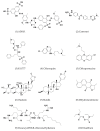Development of Small-Molecule MERS-CoV Inhibitors
- PMID: 30562987
- PMCID: PMC6316138
- DOI: 10.3390/v10120721
Development of Small-Molecule MERS-CoV Inhibitors
Abstract
Middle East respiratory syndrome coronavirus (MERS-CoV) with potential to cause global pandemics remains a threat to the public health, security, and economy. In this review, we focus on advances in the research and development of small-molecule MERS-CoV inhibitors targeting different stages of the MERS-CoV life cycle, aiming to prevent or treat MERS-CoV infection.
Keywords: MERS-CoV; mechanism of action; small-molecule inhibitor.
Conflict of interest statement
The authors declare no conflict of interest.
Figures












Similar articles
-
Nitazoxanide, a new drug candidate for the treatment of Middle East respiratory syndrome coronavirus.J Infect Public Health. 2016 May-Jun;9(3):227-30. doi: 10.1016/j.jiph.2016.04.001. Epub 2016 Apr 16. J Infect Public Health. 2016. PMID: 27095301 Free PMC article. Review.
-
[Development of peptidic MERS-CoV entry inhibitors].Yao Xue Xue Bao. 2015 Dec;50(12):1513-9. Yao Xue Xue Bao. 2015. PMID: 27169270 Review. Chinese.
-
[Small molecular agents against MERS-CoV infection].Yao Xue Xue Bao. 2015 Dec;50(12):1520-6. Yao Xue Xue Bao. 2015. PMID: 27169271 Review. Chinese.
-
Identification of a Novel Inhibitor against Middle East Respiratory Syndrome Coronavirus.Viruses. 2017 Sep 14;9(9):255. doi: 10.3390/v9090255. Viruses. 2017. PMID: 28906430 Free PMC article.
-
MERS-CoV spike protein: a key target for antivirals.Expert Opin Ther Targets. 2017 Feb;21(2):131-143. doi: 10.1080/14728222.2017.1271415. Epub 2016 Dec 21. Expert Opin Ther Targets. 2017. PMID: 27936982 Free PMC article. Review.
Cited by
-
An in silico approach to develop potential therapies against Middle East Respiratory Syndrome Coronavirus (MERS-CoV).Heliyon. 2024 Feb 9;10(4):e25837. doi: 10.1016/j.heliyon.2024.e25837. eCollection 2024 Feb 29. Heliyon. 2024. PMID: 38379969 Free PMC article.
-
Screening and identification of potential MERS-CoV papain-like protease (PLpro) inhibitors; Steady-state kinetic and Molecular dynamic studies.Saudi Pharm J. 2023 Feb;31(2):228-244. doi: 10.1016/j.jsps.2022.12.007. Epub 2022 Dec 16. Saudi Pharm J. 2023. PMID: 36540698 Free PMC article.
-
Targeting SARS-CoV-2 Proteases and Polymerase for COVID-19 Treatment: State of the Art and Future Opportunities.J Med Chem. 2022 Feb 24;65(4):2716-2746. doi: 10.1021/acs.jmedchem.0c01140. Epub 2020 Nov 13. J Med Chem. 2022. PMID: 33186044 Free PMC article. Review.
-
Repurposing Chloroquine Against Multiple Diseases With Special Attention to SARS-CoV-2 and Associated Toxicity.Front Pharmacol. 2021 Apr 12;12:576093. doi: 10.3389/fphar.2021.576093. eCollection 2021. Front Pharmacol. 2021. PMID: 33912030 Free PMC article. Review.
-
Cellular and Molecular Pathways of COVID-19 and Potential Points of Therapeutic Intervention.Front Pharmacol. 2020 Jul 29;11:1169. doi: 10.3389/fphar.2020.01169. eCollection 2020. Front Pharmacol. 2020. PMID: 32848776 Free PMC article.
References
-
- Cotten M., Watson S.J., Zumla A.I., Makhdoom H.Q., Palser A.L., Ong S.H., Al Rabeeah A.A., Alhakeem R.F., Assiri A., Al-Tawfiq J.A., et al. Spread, circulation, and evolution of the middle east respiratory syndrome coronavirus. mBio. 2014;5:e01062-13. doi: 10.1128/mBio.01062-13. - DOI - PMC - PubMed
-
- Arabi Y.M., Arifi A.A., Balkhy H.H., Najm H., Aldawood A.S., Ghabashi A., Hawa H., Alothman A., Khaldi A., Al Raiy B. Clinical course and outcomes of critically ill patients with middle east respiratory syndrome coronavirus infection. Ann. Intern. Med. 2014;160:389–397. doi: 10.7326/M13-2486. - DOI - PubMed
Publication types
MeSH terms
Substances
LinkOut - more resources
Full Text Sources
Other Literature Sources

